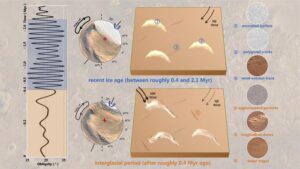
One of the recurring themes around this site is the possibility that Mars and Venus may once have been habitable planets at the same time as Earth. We don’t yet know why Venus became so uninhabitable, but we understand, to a degree, what happened to Mars. Put simply, it didn’t hold onto its atmosphere and cooled off and dried out. This is only part of the story, however. Even if Mars was larger and able to better hold onto its atmosphere, its environment still may not have been conducive to the long slow evolution of advanced life – and even cultures – that we see here on Earth.
Again – the reason can be put simply: Mars doesn’t have a large moon, and this means its environment radically changes on timescales as short as 100,000 years and as often as every few million years.
While that may seem like extremely long durations, humans in one form or another have existed for a million years. Dinosaurs last stomped the Earth 66 million years ago. The time scales of humans and life need stability across millions of years to allow evolution.
Mars’ tilt changes from 15 to 35 degrees over just 5 million years, and with this change wild changes in the distribution of ice and even dunes and other geologic features has occurred. We understand a lot of this from computer modeling, but sometimes we get lucky and find ways to measure the changes through observations. From orbiting platforms, we can measure the signals of buried ices from past glacier eras, and we can see the river beds of past water flow. Our theories are largely built from this orbital data, and the rovers and landers let us confirm … or update … our theories based on their ground-truth data.
In a new paper appearing in Nature and led by Jianjun Liu, researchers use data from China’s Zhurong rover to study how the signature of ancient dunes points to a massive change in wind direction.

While traveling across Utopia Planitia, the rover observed landforms consistent with the region once being home to dunes that were formed and moved under the influence of north-easterly winds. These dunes compressed into sediments that have since been eroded away under the influence of north-westerly winds. This kind of a “They were built” and “they were eroded” change in wind patterns is consistent with a 70 degree change in typical wind direction. This is like saying the wind in the midwest shifted from primarily west to east, to primarily south south-west to North north-east. It is believed that this change came at the end of the last Martian ice age 400,000 years ago.
And it matches what we hoped to see.
And with more work, it will let us better understand Mars past even further back in time. 3.55 to 1.8 billion years ago, Mars was wet and what happened then… well that’s what we really want to know. Researchers have named that era of Mars past the Amazonian.
According to research team member Li Chunlai, “Understanding the Amazonian climate is essential to explain the current Martian landscape, volatile matter reservoirs and atmospheric state, and to relate these current observations and active processes to models of the ancient climate of Mars. Observations of the current climate of Mars can help refine physical models of Martian climate and landscape evolution, and even form new paradigms.”
Reference:
Liu, J., Qin, X., Ren, X. et al. Martian dunes indicative of wind regime shift in line with end of ice age. Nature 620, 303–309 (2023). https://doi.org/10.1038/s41586-023-06206-1
